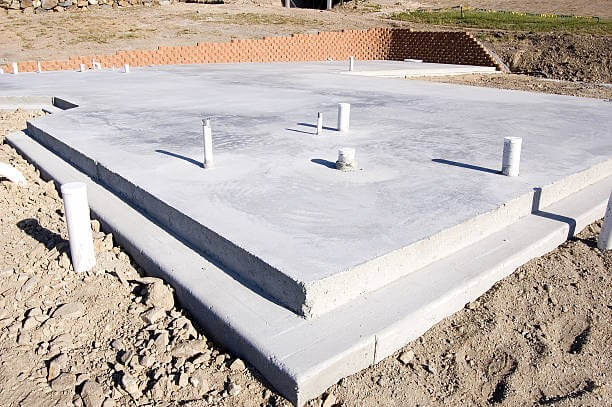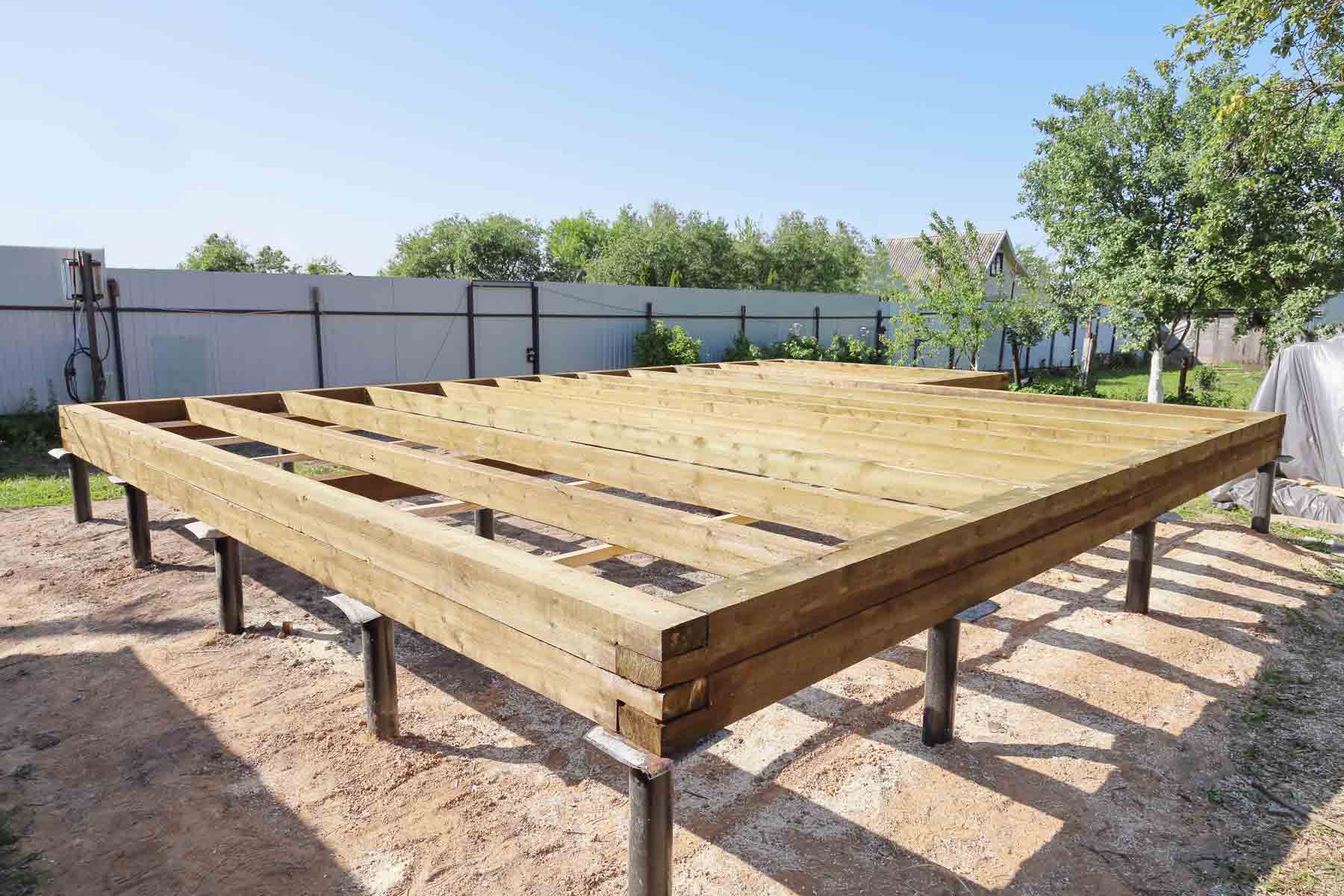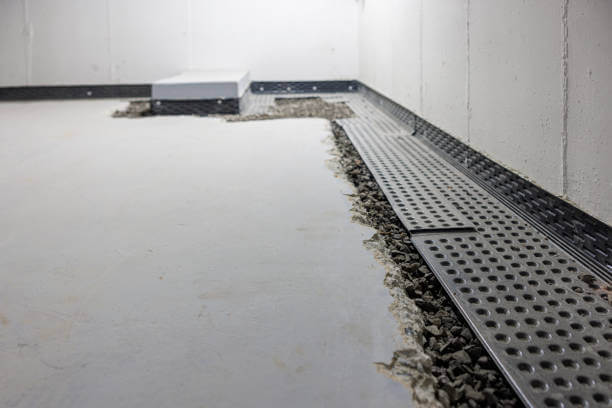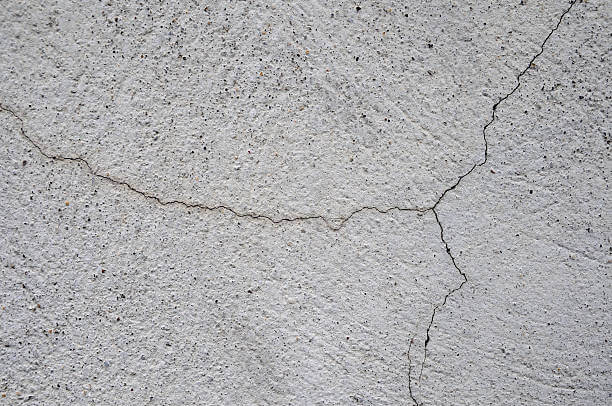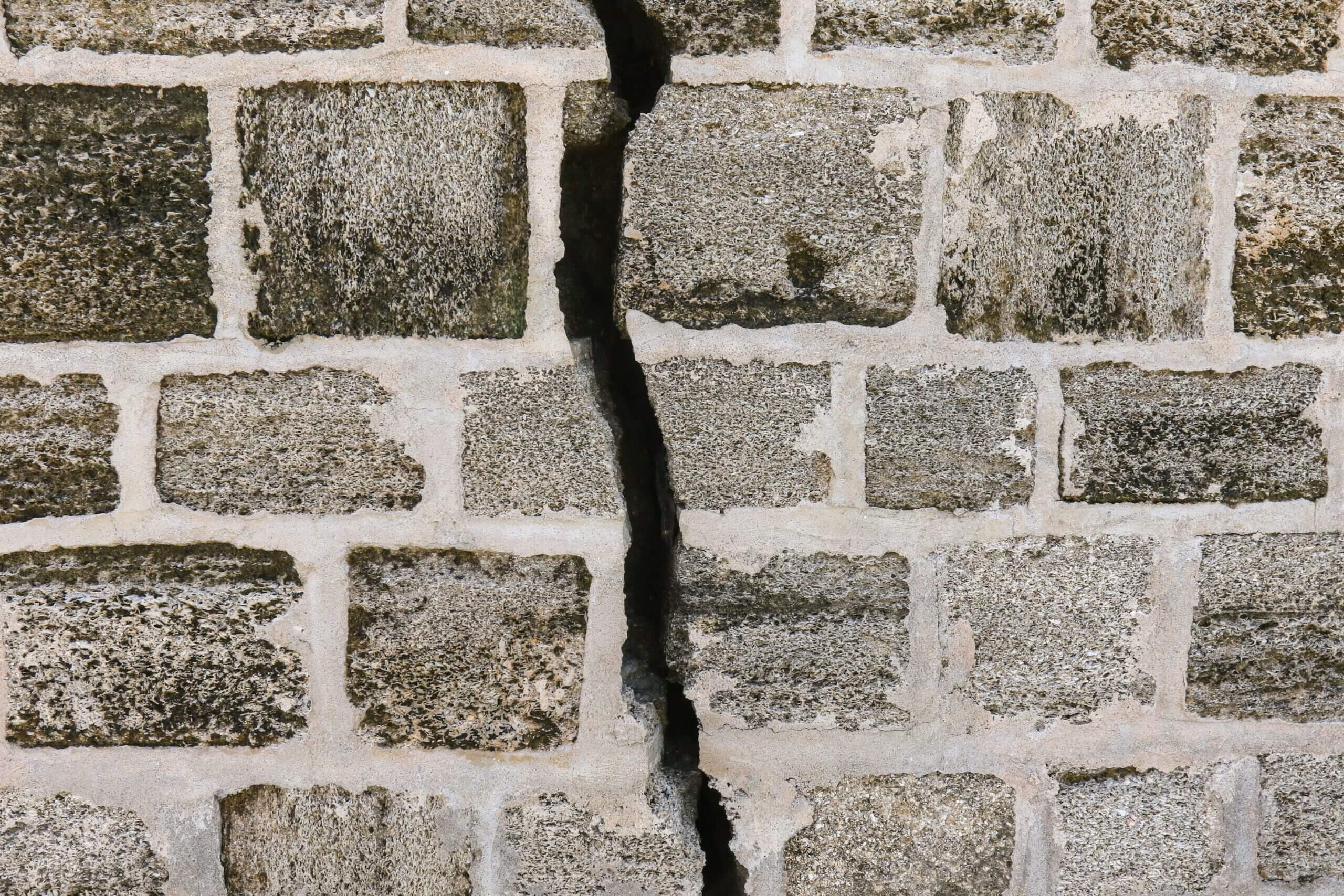What Are the Main Parts of a Foundation?
A home foundation is made up of several key components that work together to support the structure and protect it from soil movement and water damage. The main parts include footings, foundation walls, slabs, reinforcement, drainage elements, and sill plates. Depending on the design, some homes also use piers, beams, or crawl space supports.
We’ll go into more detail below, but first, here’s a quick look at the composition of many house foundations:
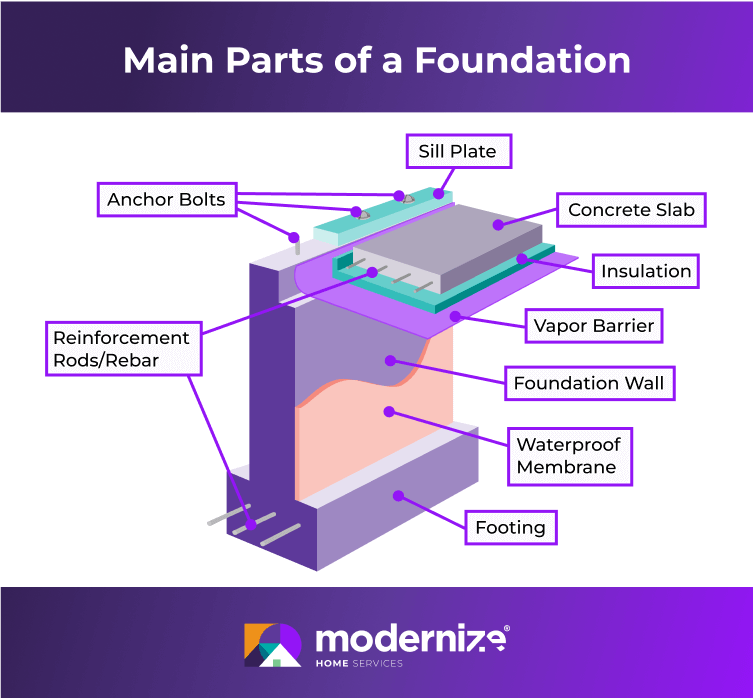
Understanding these components helps homeowners spot potential issues early, choose the right foundation type for their property, and know when to call a professional for repairs.
Footings
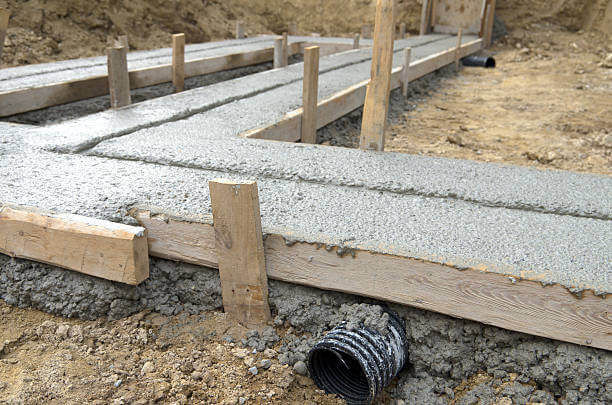
Let’s start with the base: footings. They are wide strips or pads of poured concrete placed below the frost line to support the foundation walls or slab above. Their main role is to distribute the weight of the house evenly into the soil, preventing cracks and uneven settling.
Well-designed footings provide stability for decades, but problems can arise when they are:
- Too shallow — more likely to shift during freeze-thaw cycles.
- Undersized — unable to handle the weight of the home.
- Poorly reinforced — more prone to cracking and long-term settling.
» Read about the difference between footings and foundations.
Foundation Walls
Foundation walls rise from the footings and support the structure above. They also enclose basements or crawl spaces, creating both stability and usable space. These walls are most commonly built from poured concrete, concrete block, or, in older homes, stone or brick.
Strong walls are essential for keeping a home safe and dry, but they can develop problems over time, including:
- Cracks from soil pressure or settling
- Bowing or leaning due to poor drainage or weak reinforcement
- Moisture intrusion that leads to damp basements or mold
Reinforcement (Steel or Mesh)
Concrete is strong under compression but weak under tension, which makes it vulnerable to cracking and shifting. To strengthen it, most modern foundations use reinforcement materials like steel rebar or wire mesh.
Reinforcement helps by:
- Reducing cracks caused by soil pressure or settling
- Improving durability against shifting soils and water pressure
- Extending the lifespan of slabs, walls, and footings
If reinforcement is skipped or poorly installed, the foundation is more likely to crack, bow, or fail prematurely.
Vapor Barrier, Insulation, and Waterproofing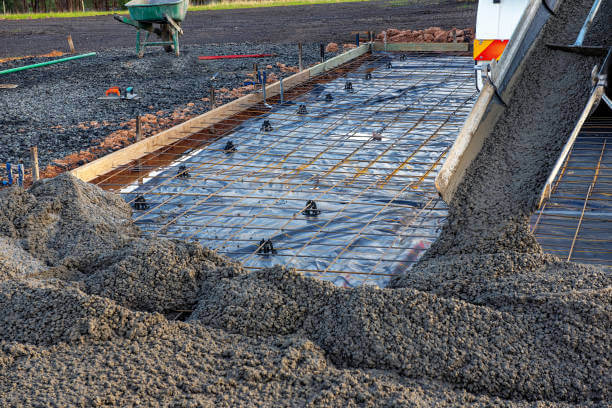
Moisture is one of the biggest threats to a foundation. That’s why most modern foundations include multiple layers of protection:
- Vapor Barriers: Plastic sheets installed under slabs or along walls to stop ground moisture from seeping inside.
- Insulation: Helps regulate basement or crawl space temperatures, improving comfort and energy efficiency.
- Waterproofing Systems: Exterior coatings, drainage mats, or sealants that block groundwater and reduce leaks.
When these systems are missing or fail, foundations are more vulnerable to dampness, mold, and water damage. Together, they keep the foundation dry, strong, and energy-efficient.
Slab or Floor
Next is the concrete slab or floor, which forms the flat surface at the bottom of the foundation. In homes with a slab-on-grade foundation, the slab is the foundation. In homes with basements or crawl spaces, the slab works as the floor surface.
Slabs usually have steel reinforcement and a vapor barrier to keep ground moisture out. Homeowners should look for cracks in the slab, as these can indicate settling or shifting beneath.
Drainage Elements
Water is one of the biggest threats to any foundation. To protect against it, many homes use drainage systems that redirect water away from the foundation and reduce hydrostatic pressure on the walls.
Common drainage features include:
- French drains or perforated pipes — collect and carry water away from the house.
- Gravel beds or drain tiles — improve soil drainage around the foundation.
- Sump pumps — remove groundwater that collects in basements or crawl spaces.
Without proper drainage, water can build up around the foundation, leading to leaks, cracks, and even structural failure over time.
Sill Plates and Anchor Bolts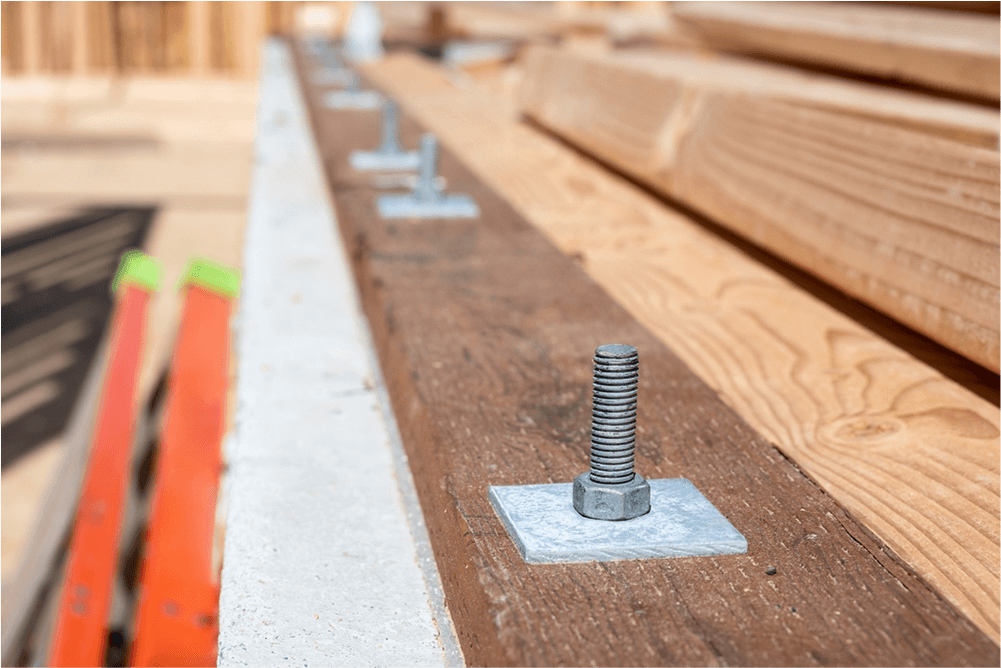
At the top of the foundation walls, sill plates form the critical connection between the concrete and the wooden structure of the home. Made of pressure-treated lumber, they provide the base for the home’s framing.
To secure them in place, builders use anchor bolts or metal straps embedded in the concrete. These fasteners keep the structure from shifting due to wind, settling, or even seismic activity.
Because sill plates sit close to the ground, they are vulnerable to rot, moisture, and termites. Adding a sill seal or gasket underneath can improve energy efficiency and help protect against drafts and damage.
Piers, Beams, and Other Supporting Elements
Some foundations rely on piers and beams as structural supports, especially in crawl space or pier and beam foundations.
- Piers: These are vertical supports made of concrete, masonry, or steel. They carry the load of the house down into the soil.
- Beams: These are horizontal supports, often made of wood or steel. They rest on piers and help spread the weight across the foundation.
These elements are not in every foundation, but when they are present, they help keep the structure stable and secure.
» Related: What is a raised foundation?
How Parts Differ by Foundation Type
Now that we’ve covered the main components, let’s look at how they differ across common foundation types.
Slab-on-Grade Foundations
A slab foundation is a single layer of poured concrete that sits directly on the ground. Its key components include the slab itself, reinforcing steel, a vapor barrier, and sometimes insulation for energy efficiency.
» Learn more about concrete slab foundations
Crawl Space Foundations
In contrast, a crawl space foundation elevates the home a few feet above the ground. Main components include short foundation walls, piers or columns, ventilation openings, and vapor barriers.
» Learn more about crawl space foundations
Basement Foundations
On the other hand, a basement foundation extends several feet underground, creating additional living or storage space. Its parts include basement walls, footings, a concrete floor slab, waterproofing systems, and insulation.
Why It’s Important to Hire a Reputable Foundation Pro
The parts of a foundation might seem simple, but proper installation and maintenance are very important. If footings are poured too shallow, if reinforcement is skipped, or if drainage is not set up correctly, serious problems can arise. Common foundation issues from poor installation include:
- Uneven settling and cracked walls
- Water intrusion and basement flooding
- Bowing or leaning foundation walls
- Sloping floors and gaps around doors or windows
Choosing a good foundation contractor or structural engineer ensures that everything is designed and built correctly for your soil, climate, and home type. Picking the right pro protects your investment and prevents expensive repairs later. Modernize can connect you with top foundation pros in your area. Click below to get started.
Compare top-rated foundations pros in your area.
Read real homeowner reviews, explore qualifications, and view promotions. Modernize makes it easy to browse professionals and find one that will be perfect for your project.




